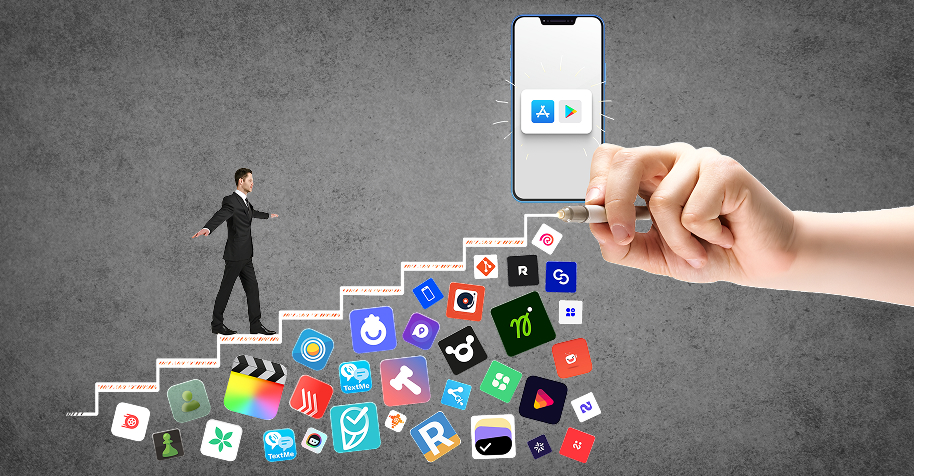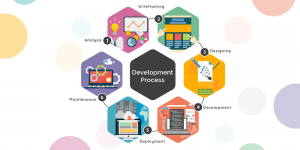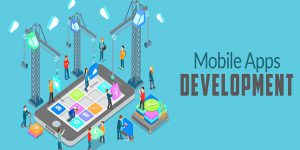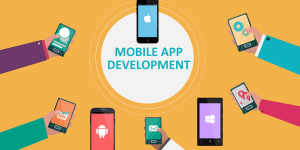
Mobile app development has emerged as the foundation of digital innovation by revolutionizing how firms engage with their customers and how consumers interact with technology. You are at a time when more than 6.8 billion individuals own smartphones around the world making mobile applications key drivers of success in every sector.
The path from concept to App Store is not merely about coding and design it is a strategic process requiring meticulous planning, accurate execution and unshakeable devotion to detail. You may have the greatest app idea but in the absence of a systematic approach even the best ideas can remain short of their best.
A systematic timeline is your guide for the whole mobile app development timeline. It will take you through the most important stages starting from brainstorming sessions to the happiness of your apps live presence on the App Store. You’ll find that successful apps do not derive from hurried development cycles or random planning.
Your app store success strategy starts with knowing that every step builds on the last one creating a foundation that will support long-term growth and user happiness well beyond the launch.
1. Idea Formulation and Research
The foundation of any successful mobile app begins with app idea brainstorming sessions that transform abstract concepts into concrete solutions. You need to identify specific problems your app will solve and define your target audience clearly. During brainstorming, document every feature idea, user scenario and potential use case that emerges from your team discussions.
Market research for apps validates whether your concept has genuine demand and commercial viability. This critical phase involves:
● Competitor analysis: Examine similar apps in your category their features, pricing models and user reviews
● Target audience research: Survey potential users to understand their pain points and preferences
● Market size assessment: Determine the total addressable market and revenue potential
● Trend analysis: Identify emerging patterns in your app category
You would need to spend 1 to 2 weeks on this discovery stage as rigorous testing avoids expensive pivots down the line. Services such as Google Trends, App Annie and SimilarWeb offer actionable insights into competitor performance and market demand. This foundation directly informs your go to market and apps feature prioritization strategy.
2. Design and Pre-Development Phase

The UI/UX design process turns your approved idea into a visual guide for development. This stage usually lasts 3 to 9 weeks and sets the groundwork for how users will interact with your app and its visual style.
➢ Creating Wireframes
Wireframes are like the architectural framework of your app. They help you plan out:
1. Screen layouts
2. Navigation flows
3. Placement of key features
During this phase you will focus on the structure of your app without getting caught up in colors or graphics. Tools such as Figma, Sketch or Adobe XD can assist you in creating these blueprints that outline how users will navigate through your application.
➢ Designing App Mockups
Once your wireframes are ready it is time to add some life to them with app mockups. This is where you bring in actual design elements such as:
● Color schemes that align with your brand identity
● Typography choices that enhance readability across different devices
● Interactive prototypes that simulate user interactions
● Consistent design patterns for buttons forms and navigation components
Your mockups should not only represent your visual identity and branding but also adhere to usability standards. This visual representation allows stakeholders to experience the apps look and feel before development begins minimizing expensive changes during the coding phase.
3. App Architecture and Development
The coding phase transforms your wireframes and mockups into a functional application. App architecture design serves as the foundation, determining how your apps components interact and scale over time. You need to choose between native development (separate codebases for iOS and Android) or cross platform solutions like React Native or Flutter.
Your development team must establish a scalable app architecture that matches your apps complexity level. Simple apps might use basic MVC patterns while complex applications require a microservices architecture with proper database design and API integration. The architecture decisions you make now directly impact your apps performance, maintainability and ability to handle future feature additions.
Writing clean, maintainable code is essential when cross-compiling to multiple platforms. Your developers should use platform-specific documentation Swift or Objective-C for iOS, Kotlin or Java for Android. Code structure, adequate commenting and version control systems such as Git allow your development team to easily work together and make changes without breaking existing functionality.
The From Idea to App Store: Timeline of Mobile App Development heavily depends on architectural choices made during this phase as complex integrations and poor planning can extend development timelines significantly.
4. Testing and Quality Assurance
Your apps success depends on thorough testing that identifies problems before users experience them.
➢ Functional Testing
It ensures that each feature operates as expected, covering aspects like user authentication, data processing and navigation flows. It is important to test every button, form submission and user interaction to guarantee uniform behavior in various situations.
➢ Integration Testing
It is important for validating the communication between your frontend and backend services. This layer of testing confirms that API calls return the expected data, database transactions are completed successfully and third-party services integrate smoothly. You should also test data synchronization between local storage and cloud databases, payment gateway connections and push notification delivery systems.
➢ Multiple Testing Approaches
To enhance your quality assurance efforts consider implementing multiple testing approaches:
● Device testing: Test your app on different screen sizes, operating system versions and hardware configurations.
● Performance testing: Identify memory leaks, slow loading times and battery drain issues through performance tests.
● Security testing: Conduct tests to ensure data encryption, user privacy protection and vulnerability assessments.
● User acceptance testing: Involve real users in the testing process to validate usability and identify pain points.
➢ Automated Testing Frameworks
It can speed up this process while ensuring consistency. You can use unit tests for individual functions, UI tests for user interactions and regression tests to prevent previously fixed bugs from resurfacing.
5. Deployment and Launch Preparation
Your app has successfully gone through testing and is now ready for submission to the app stores. This stage is important and requires careful attention to the app store submission guidelines to increase the chances of approval.
➢ Apple App Store Requirements:
Make sure you have the following in place for your Apple App Store submission:
1. Set up an App Store Connect account with complete developer information.
2. Prepare high-resolution app icons (1024×1024 pixels) and screenshots for all supported devices.
3. Write a detailed app description that includes relevant keywords and links to your privacy policy.
4. Ensure compliance with Apples Human Interface Guidelines and content policies.
➢ Google Play Store Essentials:
For your Google Play Store submission ensure you have the following:
1. Configure your Google Play Console with proper app categorization.
2. Create a feature graphic (1024×500 pixels) and promotional materials.
3. Comply with the target API level requirements and support 64-bit architecture.
4. Complete the content rating questionnaire.
The review process usually takes 1 to 7 days for Apple and 2 to 3 days for Google Play. Its important to be prepared for potential rejections by thoroughly reviewing store policies in advance. Common reasons for rejection include incomplete metadata, violations of privacy policy or technical issues that were missed during testing.
To streamline your submission workflow create a launch checklist that includes final code signing, preparation of release notes and optimization of marketing assets.
6. Post-launch Support and Maintenance

Your apps journey does not end with its App Store debut. Post-launch support becomes the foundation for long-term success, requiring continuous attention to user experience and technical performance.
Monitoring user feedback through app store reviews, in-app analytics and customer support channels reveals critical insights about your apps real world performance. You will discover which features users love which ones cause confusion and where technical issues emerge most frequently.
App updates serve as your primary tool for maintaining user satisfaction and competitive edge. Regular releases addressing bug fixes demonstrate your commitment to quality while feature enhancements keep users engaged. You should establish a systematic update schedule that balances user expectations with development resources.
Key maintenance activities include:
● Performance monitoring through crash analytics and user behavior tracking
● Security patches to protect user data and maintain compliance
● Compatibility updates for new iOS and Android versions
● Feature iterations based on user feedback and market trends
This ongoing cycle ensures your app remains relevant, functional and valuable to users long after its initial launch.
7. Factors Influencing Development Timeline
The complexity of the app has a significant impact on your development schedule. Simple apps with basic features like calculators or note-taking tools usually take 5-8 weeks to develop. These applications have simple user interfaces, minimal backend requirements and standard device integrations.
➢ Medium Complexity Apps
Such apps require 8 to 14 weeks due to additional features such as:
● User authentication systems
● Database integration
● Push notifications
● Social media connectivity
● Basic analytics tracking
➢ Complex Applications
Such applications take 14 to 24+ weeks or more to develop. These feature rich apps have sophisticated features such as real time messaging, payment gateways, GPS navigation, machine learning and massive third-party API integrations.
Your platform selection also plays an important part in how much longer development will be. Native iOS or Android development tends to be faster than cross-platform. But if you are developing for both platforms simultaneously it will double your development work.
The size and expertise of your team will directly impact how streamlined the timeline is. Expert developers are able to get past problems more efficiently and larger teams can efficiently work on things at once if they are well planned.
8. Best Practices for Streamlining Mobile App Development
Upfront planning benefits cannot be overstated when you are aiming to deliver your app efficiently. Thorough initial planning acts as your foundation by preventing costly rework that can derail timelines and budgets. You need to invest time in detailed requirement gathering, creating comprehensive project documentation and establishing clear milestones before writing a single line of code.
Agile methodology adoption transforms your development process through iterative sprints and continuous feedback loops. You will identify issues early, adapt to changes quickly and maintain momentum throughout the project lifecycle.
Key streamlining strategies include:
● Transparent communication among all stakeholders to prevent misunderstandings
● Pre-built tools and cloud-based solutions to accelerate development cycles
● Automated testing frameworks that catch bugs before they reach production
● MVP-first approach to validate concepts and gather user feedback early
You should prioritize creating detailed wireframes and prototypes during the planning phase. This visual roadmap helps your development team understand exact requirements, reducing back and forth discussions and preventing scope creep that typically extends project timelines.
9. Typical Timelines by App Complexity
Understanding the simple app timeline helps you set realistic expectations for your mobile app development journey. Simple applications with basic functionality typically require 3-5 months to complete the entire development cycle from concept to App Store approval.
➢ Simple App Characteristics:
● Basic user interface with minimal screens
● Standard features like login, profile management and basic content display
● Single platform deployment (iOS or Android)
● Limited third-party integrations
● Straightforward backend requirements
The From Idea to App Store: Timeline of Mobile App Development for simple apps breaks down as follows:
● Idea & Research: 1 to 2 weeks
● Design Phase: 2 to 3 weeks
● Development: 6 to 10 weeks
● Testing: 2 to 3 weeks
● App Store Submission: 1 to 2 weeks
Medium complexity apps extend this timeline to 5 to 8 months, incorporating features like real-time messaging, payment gateways and custom animations. Complex applications with advanced functionalities, multiple integrations and sophisticated backend systems require 8+ months to reach market readiness.
Your apps specific requirements directly impact these timeframes making accurate scope definition essential during the planning phase.
Conclusion
Your mobile app development roadmap summary shows that turning an idea into a successful App Store launch requires careful planning and execution across multiple phases. The journey From Idea to App Store: Timeline of Mobile App Development takes 3 to 9+ months depending on how complex your app is and what features it needs.
Success depends on following proven best practices that ensure both timely delivery and quality outcomes:
● Thorough upfront planning minimizes costly rework and scope creep
● Agile development methodologies with iterative sprints maintain momentum
● Comprehensive testing phases prevent post-launch issues and user dissatisfaction
● Clear communication channels keep stakeholders aligned throughout development
You can significantly improve your chances of success by starting with an MVP approach, leveraging experienced development teams and maintaining realistic timeline expectations. Remember that rushing through critical phases like testing and quality assurance often leads to longer term delays and higher costs.
The mobile app development process rewards patience, preparation and following established workflows. Your commitment to following this structured roadmap will position your app for successful launch and sustained market performance.






